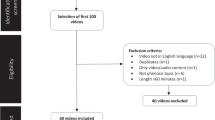Abstract
Background
There are numerous videos related to rhinoplasty on TikTok in China. The objective is to examine videos on Chinese TikTok regarding rhinoplasty surgery and evaluate the content quality of rhinoplasty-related videos on TikTok.
Method
We collected 184 Chinese video samples related to rhinoplasty and extracted basic information. We used the PEMAT-A/V tool to evaluate each video.
Results
A total of 184 videos were included in the study. The sampled videos received approximately 4.8 million likes, 900,000 comments, and 300,000 favorites. Most of the videos (n = 130, 70.65%) were posted by certified plastic surgeons on the TikTok platform. This study found that 6 (3.26%) videos contained obvious errors or misleading information. Regarding the PEMAT-A/V, the median total score was 85.71 (n = 184, IQR = 78.57–92.45%). Videos created by plastic surgeons had the highest comprehension score (n = 130, median = 100%, IQR = 91.67–100%), while videos from news media (n = 16, median = 75%, IQR = 70.76–77.34%) had the lowest usability and PEMAT-A/V total scores. In terms of video content, the PEMAT-A/V total score for surgical risks/contraindications related content (n = 15, median = 92.86%, IQR = 83.48–92.86%) was the highest, while scores for complaint-related content (n = 20, median = 75, IQR = 71.43–78.57%) were the lowest.
Conclusions
This study is the first report in China to evaluate the quality of information in nose plastic surgery-related videos on TikTok. We found that the quality of videos created by plastic surgeons on the TikTok platform is generally high, while videos provided by news media have lower quality. We encourage healthcare professionals to share more high-quality information on TikTok and educate patients on how to properly handle misinformation.
Level of Evidence IV
This journal requires that authors assign a level of evidence to each article. For a full description of these Evidence-Based Medicine ratings, please refer to the Table of Contents or the online Instructions to Authors www.springer.com/00266.


Similar content being viewed by others
References
Rohrich RJ, Ahmad J (2016) A practical approach to rhinoplasty. Plast Reconstr Surg 137(4):725e–746e. https://doi.org/10.1097/prs.0000000000002240
Lee PB, Miano DI, Sesselmann M et al (2022) RealSelf social media analysis of rhinoplasty patient reviews. J Plast Reconstr Aesthet Surg JPRAS 75(7):2368–2374. https://doi.org/10.1016/j.bjps.2022.02.060. PubMedPMID:35367160;eng
Obeid FM, Mortada H, Alsulaiman M et al (2022) The use of social media and its influence on undergoing rhinoplasty. Plast Reconstr Surg Glob Open 10(6):e4375. https://doi.org/10.1097/gox.0000000000004375. PubMedPMID:35784183; PubMedCentralPMCID:PMCPMC9242401.eng
Taha M, AlZubaidi HAA, Alkhairy IH et al (2023) The influence of social media on the decision of rhinoplasty among adults in the Western and Southern Regions of Saudi Arabia: a comparative cross-sectional study. Cureus15(6):e40137. https://doi.org/10.7759/cureus.40137. PubMedPMID:37425542; PubMedCentralPMCID:PMCPMC10329478.eng
Chen K, Zhou L, Zhao R, et al (2022) Assessing the quality of hearing aids-related videos on TikTok. Front Public Health 10.
Eghtesadi M, Florea A (2020) Facebook, Instagram, Reddit and TikTok: a proposal for health authorities to integrate popular social media platforms in contingency planning amid a global pandemic outbreak. Can J Public Health 111(3):389-391. https://doi.org/10.17269/s41997-020-00343-0. PubMed PMID: 32519085; PubMed Central PMCID: PMCPMC7282468.eng.
Comp G, Dyer S, Gottlieb M (2021) Is TikTok the next social media frontier for medicine? AEM Educati Train 5(3). https://doi.org/10.1002/aet2.10532. PubMed PMID: 34095694; PubMed Central PMCID: PMCPMC8155692.eng.
Om A, Ijeoma B, Kebede S et al (2021) Analyzing the quality of aesthetic surgery procedure videos on TikTok. Aesthet Surg J 41(12):2078–2083. https://doi.org/10.1093/asj/sjab291. PubMedPMID:34297053;eng
Charnock D, Shepperd S, Needham G et al (1999) DISCERN: an instrument for judging the quality of written consumer health information on treatment choices. J Epidemiol Community Health 53(2):105–111. https://doi.org/10.1136/jech.53.2.105. PubMedPMID:10396471; PubMedCentralPMCID:PMCPMC1756830.eng
Shoemaker SJ, Wolf MS, Brach C (2014) Development of the Patient Education Materials Assessment Tool (PEMAT): a new measure of understandability and actionability for print and audiovisual patient information. Patient Educ Couns 96(3):395–403. https://doi.org/10.1016/j.pec.2014.05.027. PubMedPMID:24973195; PubMedCentralPMCID:PMCPMC5085258.eng
Sampige R, Rodgers EG, Huang A et al (2024) Education and misinformation: exploring ophthalmology content on TikTok. Ophthalmol Therapy 13(1):97–112. https://doi.org/10.1007/s40123-023-00834-6. PubMedPMID:37875699;PubMedCentralPMCID:PMCPMC10776549.eng
Bai G, Pan X, Zhao T et al (2022) Quality assessment of YouTube videos as an information source for testicular torsion. Front Public Health 10:905609. https://doi.org/10.3389/fpubh.2022.905609. PubMedPMID:35664123;PubMedCentralPMCID:PMCPMC9157819.eng
Madathil KC, Rivera-Rodriguez AJ, Greenstein JS et al (2015) Healthcare information on YouTube: a systematic review. Health Informatics J 21(3):173–194. https://doi.org/10.1177/1460458213512220. PubMedPMID:24670899;eng
Oremule B, Patel A, Orekoya O et al (2019) Quality and reliability of YouTube videos as a source of patient information on rhinoplasty. JAMA Otolaryngol Head Neck Surg 145(3):282–283. https://doi.org/10.1001/jamaoto.2018.3723. PubMedPMID:30605207;PubMedCentralPMCID:PMCPMC6440240.eng
Acknowledgements
The authors declare that they have no conflict of interest.
Funding
The authors received no financial support for the research, authorship, and/or publication of this article.
Author information
Authors and Affiliations
Corresponding author
Ethics declarations
Conflict of interest
The authors declare that they have no conflicts of interest to disclose.
Statement of Human and Animal Rights, or Ethical Approval
This article does not contain any studies with human participants or animals performed by any of the authors.
Informed Consent/Patient Consent
This study did not require any regulatory approval. No informed consent is required because patients are not involved.
Additional information
Publisher's Note
Springer Nature remains neutral with regard to jurisdictional claims in published maps and institutional affiliations.
Rights and permissions
Springer Nature or its licensor (e.g. a society or other partner) holds exclusive rights to this article under a publishing agreement with the author(s) or other rightsholder(s); author self-archiving of the accepted manuscript version of this article is solely governed by the terms of such publishing agreement and applicable law.
About this article
Cite this article
Chen, K., Cai, Y. & Jiang, L. TikTok Videos Related to Rhinoplasty in China: Characteristics and the Quality of the Information. Aesth Plast Surg (2024). https://doi.org/10.1007/s00266-024-03940-3
Received:
Accepted:
Published:
DOI: https://doi.org/10.1007/s00266-024-03940-3




